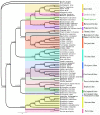A mitogenomic perspective on the phylogenetic position of the Hapalogenys genus (Acanthopterygii: Perciformes) and the evolutionary origin of Perciformes
- PMID: 25077480
- PMCID: PMC4117523
- DOI: 10.1371/journal.pone.0103011
A mitogenomic perspective on the phylogenetic position of the Hapalogenys genus (Acanthopterygii: Perciformes) and the evolutionary origin of Perciformes
Abstract
The Hapalogenys genus was the most controversial and problematic in phylogenetic position of Percoidei. In this study, we rechecked the taxonomic status of Hapalogenys in Percoidei using complete mitochondrial genome data. We purposefully added a new complete mitochondrial sequence from chosen species of Hapalogenys and conducted phylogenetic analyses using a large complete mitochondrial data set. The resultant tree topologies were congruent from partitioned Bayesian and Maximum-likelihood methods. The results indicated that Hapalogenys was distantly related to Haemulidae and could be removed from Haemulidae. The results supported the Hapalogeny was upgraded to a family rank titled Hapalogenyidae, and it should be recognized in a separate family of Hapalogenyidae. A relaxed molecular-clock Bayesian analysis indicated that the divergence times of Perciformes groups had a much older than the available old fossil records. The origin of the common ancestral lineage of Perciformes fish was estimated in the late Jurassic about 149 Myr ago.
Conflict of interest statement
Figures



References
-
- Nelson JS (2006) Fishes of the World, fourth ed. Hoboken-New Jersey: John Willey and Sons.
-
- Miller TL, Cribb TH (2007) Phylogenetic relationships of some common Indo-Pacific snappers (Perciformes: Lutjanidae) based on mitochondrial DNA sequences, with comments on the taxonomic position of the Caesioninae. Mol Phylogenet Evol 44: 450–460. - PubMed
-
- Song CB, Near TJ, Page LM (1998) Phylogenetic Relations among Percid Fishes as inferred from Mitochondrial Cytochrome b DNA Sequence Data. Mol Phylogenet Evol 10: 343–353. - PubMed
-
- Iwatsuki Y, Russell BC (2006) Revision of the genus Hapalogenys (Teleostei: Perciformes) with two new species from the Indo-West Pacific. Memoirs of Museum Victoria 63: 29–46.
-
- Springer VG, Raasch MS (1995) Fishes, angling, and finfish fisheries on stamps of the world. American Topical Association, Handbook 129: 1–110.
Publication types
MeSH terms
Associated data
- Actions
LinkOut - more resources
Full Text Sources
Other Literature Sources

